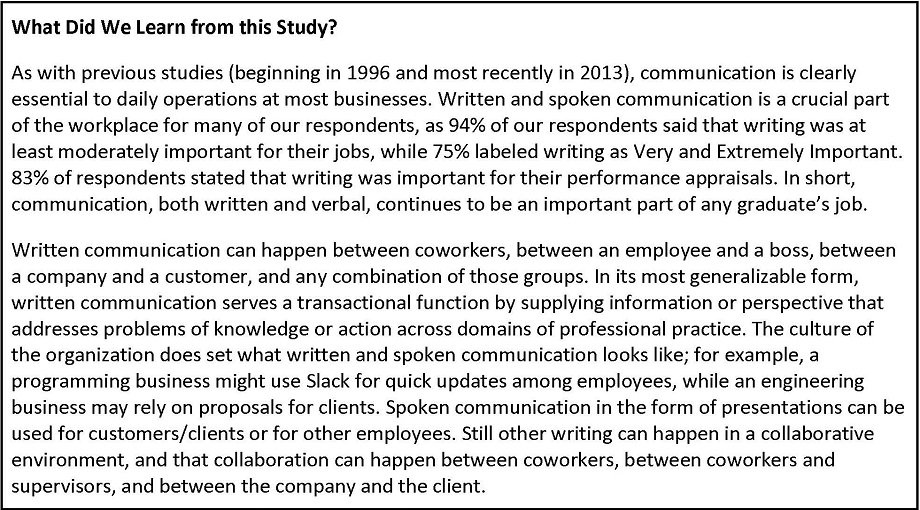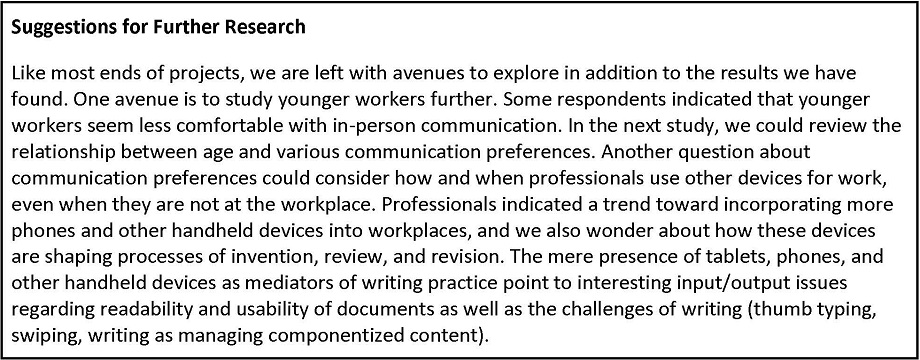20 – Recommendation Reports
Conclusions
David McMurrey; Annemarie Hamlin; Chris Rubio; Michele DeSilva; Kalani Pattison; and Nicole Hagstrom-Schmidt
Writers sometimes use the word “conclusion” to refer to the last section or paragraph of a document. However, in report writing term refers to one of a few specific types of sections. In the case of a report with a results or findings section, the conclusions is often the section that contains the analysis and synthesis of those reported results. There are at least four ways to end a report: a “true” conclusion, a summary, an afterword, or a combination of these types.
In a recommendation or feasibility report, often the conclusion will not be the last section of the document, but a section made up of “true” conclusions that precedes the final recommendation.
“True” Conclusions
“True” conclusions are based on logic. For example, in the body of a report, you might present conflicting theories and explore the related data. Alternatively, in a researched report structured similarly to an IMRaD report, you most likely have both methods and results sections. In a “true” conclusion, you present your resolution of the conflicting theories or the logical conclusions you can draw from the results you presented.
In a “true” conclusion section within a researched report, you will likely be able to draw multiple conclusions from your research tasks, methods, and results. In fact, if you are triangulating your sources during the research phase, you may have multiple research methods that lead to the same conclusion. The secondary sources you find and the results of a survey you conduct, for instance, may lead to the same single logical conclusion or point.
On the other hand, one research task may also lead to multiple conclusions. An interview with a primary source, for instance, may give you enough details about various aspects of a project to allow you to draw multiple conclusions from the data you are given.
To write a strong “true” conclusion section, you need to step back from both results and any other sections (such as the “Recommendation” section within a recommendation report) and ask, “What do the results here imply? What do they mean?” without proceeding to the point of suggesting what action or decision should be made in response.
Summary Conclusions
Another common way to wrap up a report is to review and summarize the key points. A summary is in order if your report is long, complex, and heavily detailed, as well as if you want your readers to come away with a certain perspective. For short reports, summaries can seem absurd—the reader thinks “You’ve just told me that!” Summaries need to read as if time has passed and the writer is viewing the subject after reflection. These summary-conclusions are different from the summary often included at the beginning of a report, as they do not cover the whole of the document (introduction and context, methods, etc.) but merely summarize the findings or what the writer wants the reader to remember.
Figure 20.9[1] below offers an example of a summary-conclusion. Notice that these two paragraphs emphasize key findings and distill what they might mean within business communications, the report’s topic.

Afterwords
A rarer possibility for ending a report involves turning to some related topic but discussing it at a very general level. Imagine that you had written a background report on some exciting new technology. In the final section, you might broaden your focus and discuss how that technology might be used or the problems it might bring about. However, the key is to keep it general—do not force yourself into a whole new detailed section.
Figure 20.10[2] offers an example of an afterword-type final section. This afterword is titled “Suggestions for Further Research,” which is a heading commonly seen in research articles.

Combinations
In practice, the preceding ways of ending reports are often combined. You can analyze final sections of reports and identify elements that summarize, elements that conclude, and elements that discuss something related but at a general level (i.e., an afterword).
No matter the type of conclusion, however, avoid conclusions for which there is no basis (i.e., discussion or support) in the body of the report.
Finally, in certain types of reports, especially in recommendation or feasibility reports, conclusions are not the last section, but are rather a transition between data in a report and the final section which presents applications, recommendations, and suggestions for next actions to readers.
This text was derived from
Swarts, Jason, Stacey Pigg, Jamie Larsen, Julia Helo Gonzalez, Rebecca De Haas, and Elizabeth Wagner. Communication in the Workplace: What Can NC State Students Expect? North Carolina State University Professional Writing Program, 2018. https://docs.google.com/document/d/1pMpVbDRWIN6HssQQQ4MeQ6U-oB-sGUrtRswD7feuRB0/edit#heading=h.n2a3udms5sd5. Licensed under a Creative Commons Attribution 4.0 International License.
Gross, Allison, Annemarie Hamlin, Billy Merck, Chris Rubio, Jodi Naas, Megan Savage, and Michele DeSilva. Technical Writing. Open Oregon Educational Materials, n.d. https://openoregon.pressbooks.pub/technicalwriting/. Licensed under a Creative Commons Attribution-NonCommercial-ShareAlike 4.0 International License.
McMurrey, David. Online Technical Writing. n.d. https://www.prismnet.com/~hcexres/textbook/. Licensed under a Creative Commons Attribution 4.0 International License.
- Kalani Pattison, "Summary-Conclusion Section of a Report," 2022. Licensed under a Creative Commons Attribution-NonCommercial-ShareAlike 4.0 International License. Figure derived from Jason Swarts, Stacey Pigg, Jamie Larsen, Julia Helo Gonzalez, Rebecca De Haas, and Elizabeth Wagner, Communication in the Workplace: What Can NC State Students Expect? (Raleigh: North Carolina State University Professional Writing Program, 2018), https://docs.google.com/document/d/1pMpVbDRWIN6HssQQQ4MeQ6U-oB-sGUrtRswD7feuRB0/edit#heading=h.n2a3udms5sd5. Licensed under a Creative Commons Attribution 4.0 International License. ↵
- Kalani Pattison, "Afterword-Type Final Section," 2022. Licensed under a Creative Commons Attribution-NonCommercial-ShareAlike 4.0 International License. Figure derived from Jason Swarts, Stacey Pigg, Jamie Larsen, Julia Helo Gonzalez, Rebecca De Haas, and Elizabeth Wagner, Communication in the Workplace: What Can NC State Students Expect? (Raleigh: North Carolina State University Professional Writing Program, 2018), https://docs.google.com/document/d/1pMpVbDRWIN6HssQQQ4MeQ6U-oB-sGUrtRswD7feuRB0/edit#heading=h.n2a3udms5sd5. Licensed under a Creative Commons Attribution 4.0 International License. ↵

